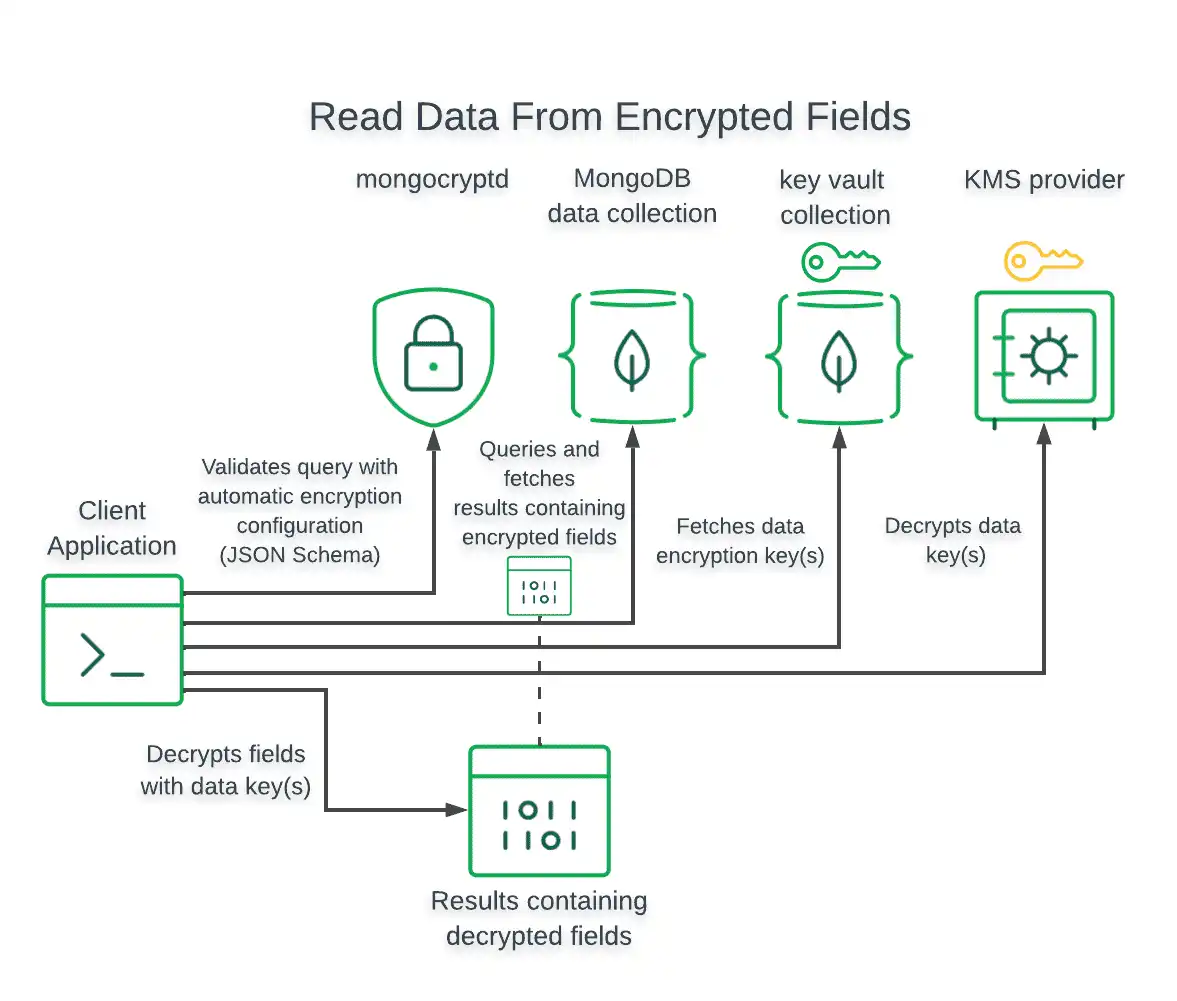MongoDB supports automatically encrypting fields in read and write
operations when using Client-Side Field Level Encryption. You can perform automatic encryption
using mongosh and official MongoDB drivers. For a complete list
of official compatible drivers with support for CSFLE, see Driver
Compatibility Client-Side Field Level Encryption Compatibility.
How Encrypted Writes and Reads Work
The following diagrams show how the client application and driver write and read field-level encrypted data.
Encrypted Writes
For write operations, the driver encrypts field values prior to writing to the MongoDB database.
The following diagram shows the steps taken by the client application and driver to perform a write of field-level encrypted data:

Encrypted Reads
For read operations, the driver encrypts field values in the query prior to issuing the read operation.
For read operations that return encrypted fields, the driver automatically decrypts the encrypted values only if the driver was configured with access to the Customer Master Key (CMK) and Data Encryption Keys (DEK) used to encrypt those values.
The following diagram shows the steps taken by the client application and driver to query and decrypt field-level encrypted data:

Enabling Automatic Client-Side Field Level Encryption
To enable automatic encryption, specify automatic encryption settings in
your client's MongoClient instance.
The following code snippets show how to create a client with automatic
encryption enabled in mongosh and MongoDB drivers:
var autoEncryptionOpts = { "keyVaultNamespace" : "<database>.<collection>", "kmsProviders" : { ... }, "schemaMap" : { ... } } cluster = Mongo( "<Your Connection String>", autoEncryptionOpts );
var clientSettings = MongoClientSettings.FromConnectionString(_connectionString); var autoEncryptionOptions = new AutoEncryptionOptions( keyVaultNamespace: keyVaultNamespace, kmsProviders: kmsProviders, schemaMap: schemaMap, extraOptions: extraOptions); clientSettings.AutoEncryptionOptions = autoEncryptionOptions; var client = new MongoClient(clientSettings);
autoEncryptionOpts := options.AutoEncryption(). SetKmsProviders(provider.Credentials()). SetKeyVaultNamespace(keyVaultNamespace). SetSchemaMap(schemaMap). SetExtraOptions(extraOptions) client, err := mongo.Connect(context.TODO(), options.Client().ApplyURI(uri).SetAutoEncryptionOptions(autoEncryptionOpts))
MongoClientSettings clientSettings = MongoClientSettings.builder() .applyConnectionString(new ConnectionString("mongodb://localhost:27017")) .autoEncryptionSettings(AutoEncryptionSettings.builder() .keyVaultNamespace(keyVaultNamespace) .kmsProviders(kmsProviders) .schemaMap(schemaMap) .extraOptions(extraOptions) .build()) .build(); MongoClient mongoClient = MongoClients.create(clientSettings);
const secureClient = new MongoClient(connectionString, { monitorCommands: true, autoEncryption: { keyVaultNamespace, kmsProviders, schemaMap: patientSchema, extraOptions: extraOptions, }, });
fle_opts = AutoEncryptionOpts( kms_providers, key_vault_namespace, schema_map=patient_schema, **extra_options ) client = MongoClient(connection_string, auto_encryption_opts=fle_opts)
For more information on CSFLE-specific MongoClient settings,
see MongoClient Options for CSFLE.
Server-Side Field Level Encryption Enforcement
MongoDB supports using schema validation to enforce encryption of specific fields in a collection. Clients performing automatic Client-Side Field Level Encryption have specific behavior depending on the database connection configuration:
If the connection autoEncryptionOpts
schemaMapobject contains a key for the specified collection, the client uses that object to perform automatic field level encryption and ignores the remote schema. At minimum, the local rules must encrypt those fields that the remote schema marks as requiring encryption.If the connection autoEncryptionOpts
schemaMapobject does not contain a key for the specified collection, the client downloads the server-side remote schema for the collection and uses it to perform automatic field level encryption.Important
Behavior Considerations
MongoDB uses schema validation to enforce encryption of specific fields in a collection. Without a client-side schema, the client downloads the server-side schema for the collection to determine which fields to encrypt. To avoid this issue, use client-side schema validation.
Because CSFLE and Queryable Encryption do not provide a mechanism to verify the integrity of a schema, relying on a server-side schema means trusting that the server's schema has not been tampered with. If an adversary compromises the server, they can modify the schema so that a previously encrypted field is no longer labeled for encryption. This causes the client to send plaintext values for that field.
To learn how to set up server-side CSFLE enforcement, see CSFLE Server-Side Schema Enforcement.